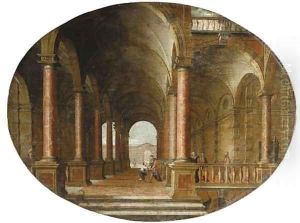Hendrick Van Steenwyck II Paintings
Hendrick van Steenwyck the Younger was a Dutch painter who played a significant role in the development of Western architectural painting during the early modern period. Born around 1580 in Antwerp, then part of the Spanish Netherlands, he was the son of Hendrick van Steenwyck the Elder, who was also a distinguished painter of architectural interiors. Van Steenwyck the Younger likely received his initial training from his father, which set the stage for his future artistic career.
Van Steenwyck moved to London by 1617, following his father's footsteps, who had previously worked there. In England, he became involved in the cultural milieu of the court and established himself as a successful artist. He was known for his skill in the depiction of interior spaces, particularly Gothic and Renaissance buildings, often embellished with human figures that were sometimes painted by other artists, such as Sir Anthony van Dyck, with whom he is known to have collaborated.
His works are characterized by their meticulous attention to the effects of light and shadow, which he used to enhance the three-dimensional quality of the space. Van Steenwyck's paintings often featured cathedrals, churches, and palaces with high ceilings and elaborate decorations, and he was particularly adept at using linear perspective to create the illusion of depth.
Throughout his career, Van Steenwyck influenced the genre of perspective views and architectural painting in England and on the Continent. His work was admired for its technical precision and its ability to convey the splendor and scale of architectural spaces. Van Steenwyck the Younger's contribution to art history is particularly noted for the way he combined the Northern European tradition of meticulous detail with Italianate conventions of perspective and space.
Hendrick van Steenwyck the Younger died in 1649, having left a legacy of influential architectural paintings that continue to be studied and appreciated for their artistic and historical significance. His works are held in various museums and collections around the world, where they are recognized for their contribution to the architectural genre in painting.
